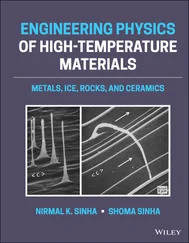1 Cover
2 Title Page SCIENCES Mechanics , Field Director – Gilles Pijaudier-Cabot Numerical Methods in Mechanics , Subject Head – Sylvain Drapier
3 Copyright First published 2021 in Great Britain and the United States by ISTE Ltd and John Wiley & Sons, Inc. Apart from any fair dealing for the purposes of research or private study, or criticism or review, as permitted under the Copyright, Designs and Patents Act 1988, this publication may only be reproduced, stored or transmitted, in any form or by any means, with the prior permission in writing of the publishers, or in the case of reprographic reproduction in accordance with the terms and licenses issued by the CLA. Enquiries concerning reproduction outside these terms should be sent to the publishers at the undermentioned address: ISTE Ltd 27-37 St George’s Road London SW19 4EU UK www.iste.co.uk John Wiley & Sons, Inc. 111 River Street Hoboken, NJ 07030 USA www.wiley.com © ISTE Ltd 2021 The rights of Christian Gogu to be identified as the author of this work have been asserted by him in accordance with the Copyright, Designs and Patents Act 1988. Library of Congress Control Number: 2020946721 British Library Cataloguing-in-Publication Data A CIP record for this book is available from the British Library ISBN 978-1-78945-010-1 ERC code: PE1 Mathematics PE1_13 Probability PE1_14 Statistics PE8 Products and Processes Engineering PE8_3 Civil engineering, architecture, maritime/hydraulic engineering, geotechnics, waste treatment PE8_7 Mechanical and manufacturing engineering (shaping, mounting, joining, separation)
4 Foreword
5 Preface
6 PART 1: Modeling, Propagation and Quantification of Uncertainties
1 Uncertainty Modeling
1.1. Introduction 1.2. The usefulness of separating epistemic uncertainty from aleatory uncertainty 1.3. Probability theory 1.4. Probability box theory (p-boxes) 1.5. Interval analysis 1.6. Fuzzy set theory 1.7. Possibility theory 1.8. Evidence theory 1.9. Evaluation of epistemic uncertainty modeling 1.10. References 2 Microstructure Modeling and Characterization 2.1. Introduction 2.2. Probabilistic characterization of microstructures 2.3. Point processes 2.4. Boolean models 2.5. RSA models 2.6. Random tessellations 2.7. Gaussian fields 2.8. Conclusion 2.9. Acknowledgments 2.10. References 3 Uncertainty Propagation at the Scale of Aging Civil Engineering Structures 3.1. Introduction 3.2. Problem positioning 3.3. Random field-based modeling of material properties 3.4. Modeling uncertainty propagation using response surface methods 3.5. Conclusion 3.6. References 4 Reduction of Uncertainties in Multidisciplinary Analysis Based on a Polynomial Chaos Sensitivity Study 4.1. Introduction 4.2. MDA with model uncertainty 4.3. Sensitivity analysis and uncertainty reduction 4.4. Application to an aeroelastic test case 4.5. Conclusion 4.6. References
7 PART 2: Taking Uncertainties into Account: Reliability Analysis and Optimization under Uncertainties 5 Rare-event Probability Estimation 5.1. Introduction 5.2. MPFP-based methods 5.3. Simulation methods 5.4. Sensitivity measures 5.5. References 6 Adaptive Kriging-based Methods for Failure Probability Evaluation: Focus on AK Methods 6.1. Introduction 6.2. Presentation of Kriging 6.3. Employing Kriging to calculate failure probabilities 6.4. The AK-MCS method: presentation and generic principle 6.5. The AK-IS method for estimating probabilities of rare events 6.6. The AK-SYS method for system reliability problems 6.7. The AK-HDMR1 method for high-dimensional problems 6.8. Conclusion 6.9. References 7 Global Reliability-oriented Sensitivity Analysis under Distribution Parameter Uncertainty 7.1. Introduction 7.2. Theoretical framework and notations 7.3. Global variance-based reliability-oriented sensitivity indices 7.4. Sobol’ indices on the indicator function adapted to the bi-level input uncertainty 7.5. Efficient estimation using subset sampling and KDE 7.6. Application examples 7.7. Conclusion 7.8. Acknowledgments 7.9. References 8 Stochastic Multiobjective Optimization: A Descent Algorithm 8.1. Introduction 8.2. Mathematical refresher 8.3. Multiobjective optimization and common descent vector 8.4. Descent algorithm for multiobjective optimization and its extension to the stochastic framework 8.5. Illustrations 8.6. References
8 List of Authors
9 Index
10 End User License Agreement
1 Chapter 1 Figure 1.1. Example of a cumulative distribution function (CDF) and a complement... Figure 1.2. Example of an empirical cumulative distribution function (ECDF, in b... Figure 1.3. Distribution function of a uniform distribution on X between [0,1] (... Figure 1.4. Illustration with a system presenting a resonance of a case where mo... Figure 1.5. Illustration of a probability box Figure 1.6. Illustration of a trapezoidal membership function in fuzzy set theor... Figure 1.7. Illustrations of (a) a possibility distribution function (PoDF); (b)... Figure 1.8. Comparison between a probability density function f(x) and a possibi... Figure 1.9. Probability density function and possibility distribution function s... Figure 1.10. Distribution function (DF), cumulative possibility function (CPoF) ... Figure 1.11. Example of an uncertainty structure (focal elements Ωi of mass mi) ... Figure 1.12. Illustrations of (a) a BPA function m(x); (b) the corresponding cum...
2 Chapter 2 Figure 2.1. “Biloba” concrete core, according to Escoda (2012) (source: EDF). Fo... Figure 2.2. Examples of stochastic models derived from random point processes: (...Figure 2.3. (a) Composite fibrous medium; (b) model (source: Altendorf et al. 20...Figure 2.4. (a) Two-dimensional section of a Johson–Mehl random partition modeli...Figure 2.5. (a and c) SEM image (after segmentation) of fuel cell anode layers; ...Figure 2.6. (a) SEM image of a fuel cell foam; (b) realization of a “Boolean ran...Figure 2.7. Random realizations of three probabilistic models with the same triv...
3 Chapter 3Figure 3.1. Principle of a weakly chained THM+L modeling. For a color version of...Figure 3.2. Containment principle for double-walled nuclear vessels Figure 3.3. Diagram of the internal wall of the VeRCoRs model, its structural pa...Figure 3.4. Evolution of cracking profile frequencies according to the spatial c...Figure 3.5. Effect of spatial correlation on the distribution of the r.v. of a l...Figure 3.6. Evolution of the relative error on variance εΩ=Gousset according to ...Figure 3.7. Examples of 12-day cracking profiles involved in the ACCD experiment...Figure 3.8. Evolution of the number of cracks per gusset RSV with the tensile st...Figure 3.9. Evaluation of the risk of exceeding the regulatory criterion overall...
4 Chapter 4Figure 4.1. (a) Finite element mesh of the structural part of the wing (skin, sp...Figure 4.2. Displacement field after convergence of the multidisciplinary analys...Figure 4.3. Circulation (a) before and (b) after convergence of the multidiscipl...Figure 4.4. Lift-to-drag ratio YQoI(z) as a function of the angle of attack z, w...Figure 4.5. Twenty random realizations of the lift-to-drag ratio YQoI (z) obtain...Figure 4.6. Histogram of the quantity of interest YQol based on the sample of si...Figure 4.7. Histogram of the quantity of interest YQoI before and after enrichme...Figure 4.8. Histogram of the quantity of interest YQoI before and after enrichme...Figure 4.9. Histogram of the quantity of interest, namely the spin angle YQoI, b...Figure 4.10. Histogram of the new quantity of interest YQoI (wingtip spin angle)...Figure 4.11. Histogram of the new quantity of interest YQoI (wingtip spin angle)...
5 Chapter 5Figure 5.1. Joint PDF fX, limit-state surface |, safe domain | and failure domai...Figure 5.2. Standard normal space. For a color version of this figure, see www.i...Figure 5.3. FORM approximation. For a color version of this figure, see www.iste...Figure 5.4. Successive use of bulges to find multiple MPFPs (Der Kiureghian and ...Figure 5.5. SORM-cf approximation. For a color version of this figure, see www.i...Figure 5.6. Concept of SORM-pf approximation in the (|, |) plane. For a color ve...Figure 5.7. Intermediate failure domains F u,sfor s = 1, …, m (here m = 3). For a...Figure 5.8. Modified Metropolis algorithm: seeds of Markov chains and proposal P...
Читать дальше












